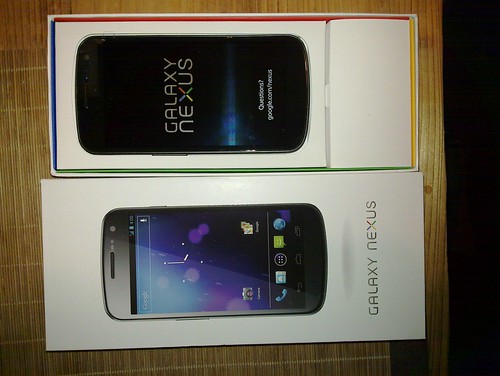After a couple of good years with my Nokia N900 I’ve come to the sad conclusion that there’s no future for that platform due to the combined actions of Nokia and Intel – Nokia for dumping Linux and going with Windows Mobile for their smart phones after getting a new CEO (ex-Microsoft) and then Intel through dumping Meego and setting up a partnership with Samsung for yet another mobile Linux platform called Tizen (which at least went for the code first, hype second path, unlike Meego). Intel are now on their third mobile Linux project as there was their Moblin project which was merged with Nokia’s Maemo to form Meego (announced less than 2 years ago) so they have form here as a serial abandoner.
Looking at what is left in the mobile space it was really a no-brainer as neither Windows Mobile nor Apple’s iOS appealed at all, so it had to be an Android phone. The timing was pretty good as Samsung and Google had just started shipping their jointly designed Galaxy Nexus with Android 4 (aka Ice Cream Sandwich or ICS). It has the advantage of apparently being a phone recommended for the AOSP (Android Open Source Program) should I feel the need once my warranty expires – though I can’t find a reference to that now! I ordered an unlocked Galaxy Nexus with 2 year warranty from Mobicity as I didn’t fancy the rubbish that carriers tend to put onto their phones, nor get handcuffed into a contract I didn’t want. As an added bonus Mobicity let you pick from 3 optional accessories for free – I picked the screen protector (the other were either a charger or a bluetooth headset from memory).
As an amusing aside I did try and see if Dick Smith Electronics would price match with Kogan for the Galaxy Nexus as Kogan was far cheaper and DSE was only selling them online, but with a manufacturers warranty (unlike Mobicity or Kogan). Unfortunately DSE declined to do so on the grounds that Kogan didn’t have a physical retail outlet which was a bit rich given that neither does DSE for these phones. But then I found out they are now owned by Woolworths and so I didn’t fancy supporting the largest owners of poker machines in Australia.
Despite the best efforts of UPS (who said it would take 6 days to cross Melbourne having taken 24 hours from Hong Kong – it actually arrived the following morning) I received it intact and on time.

I’ve now been playing with it, er, using it in anger for over a week now and so far I’m very happy. I’d have to say the best description of the overall experience is “smooth”. Android 4 seems light years ahead of Android 2.3.3 on my wifes Huaewei Sonic, though part of that will be the fact that it’s just a much more capable phone with a larger screen and much more powerful processor.
Good bits:
- Auto-language select – it started up in Chinese characters but before I could really wonder how I’d fix that it detected it had an Australian SIM in it and autoconfigured the locale to match.
- No extra cruft – I’ve not spotted any “extras” from Samsung on the phone – the Market is the standard Android Market, etc.
- Good size screen – the phone feels much smaller in the pocket than my old N900 due to its narrowness despite it having a much wider screen.
- Android Market – heaps of apps, though the usual criticism of it not being easy to search for open source applications applies here.
- Camera – it’s “only” 5 megapixels, but it’s still pretty good (though I’ve not yet figured out how to turn the flash off).
- NFC – OK, a little bit of a toy at the moment, but there are a couple of apps that will read it and confirm that the reason my Myki and Uni ID card interfere is that they’re the same type of technology and so interfere with each other. As do my credit card and my bank card (same tech again).
- Compass – my N900 had GPS and accelerometers (as does the Galaxy Nexus of course) but the compass allows neat things like Google Sky where you can just point your phone at the sky and have it show you a labelled view of planets stars and constellations.
- IPv6 works on Wifi – I know people say IPv6 has worked on Wifi since Android 2.2, but it certainly doesn’t on my wifes Android 2.3 phone. But the Galaxy Nexus seems quite happy on my home network with native dual stack IPv6 courtesy of Internode.
Of course nothing is ever perfect, so here’s my feelings on the bad bits:
- No real keyboard – I really miss the N900’s physical keyboard, it made typing easy. The on-screen keyboard that Android has is good, and quite usable for SMS, Twitter, etc, but for things like the Connectbot SSH client you can’t beat a real keyboard
- No NTP synchronisation possible – you can get root on the phone (and void your warranty) but this *really* shouldn’t be necessary!
- NITZ sucks – whilst it gets the time right the timezone is out by an hour. Probably a carrier issue but I don’t think phones should be relying on it. Had to set it by hand to fix it up.
- Short notification sounds – a minor nit but the default notification sounds that are used for things like SMS, etc, are really short and quite easy to miss.
- Not entirely open source – whilst the N900 wasn’t either it does seem to have been more open than Android, and it didn’t try and avoid GPL code at all costs like Android does.
- No update to Android 4.0.2 available (yet) – so far it appears that Samsung haven’t pushed an Android 4.0.2 update to the region my phone was intended for – though other Galaxy Nexus owners around the world have reported getting updates at other times (including someone at Mobicity where I bought it). I suspect this is just an organisational delay and nothing more serious, but it is annoying. If it wasn’t for the warranty issue I’d consider reflashing the phone with the stock Google firmware for the Galaxy Nexus and pick the updates up directly from them in future.
To finish it off here are three images taken with the camera in the Samsung Galaxy Nexus (as I said I was happy with it), the first one was used on the weather slot as a background by the ABC News people last week!






